

Our Challenge
Key Terms
-
Cork cambium
The layer of cells that produces tree bark.
-
Epicormic branching
Branches that grow out of the trunk of a tree, from buds under the bark.
-
Gallery
A tunnel or pathway in which an insect lives, feeds, or deposits eggs.
-
Larva
A newly hatched insect, before it transforms into an adult.
-
Pupa
A young insect in its inactive form, between the larva and adult stages.


Explore: Emerald Ash Borers

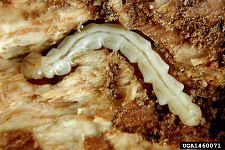



Roll over the image for each stage in the lifecycle of the emerald ash borer to learn how it is such a damaging insect for black ash trees.
Roll over or touch the image for each stage in the lifecycle of the emerald ash borer to learn how it is such a damaging insect for black ash trees.
Mid-May to Mid-August: Adult emerald ash borers lay eggs (in groups or individually) on the bark surface or in bark crevices of the black ash tree.
May to June: It takes about two to three weeks for pupae to become adults. Adults emerge from the tree leaving D-shaped exit holes.
June to August: It takes about two to three weeks for eggs hatch into larvae and chew through the outer bark as they tunnel into the cambium layer of the tree.
August to October: Larvae feed under the bark, creating s-shaped tracks or galleries. The galleries get larger as the larvae eats and disrupt the transport of nutrients and water within the tree.
November to April: Larvae spend the winter about a half an inch under the bark as they wait to become pupae and grow into adult Emerald Ash Borers.




Try These Questions
That is correct!
It hasn’t reached Akwesasne yet, but the emerald ash borer poses the biggest threat, because it has the potential to wipe out all of the black ash trees there.



That is correct!
These are healthy black ash trees growing in a wetland.
That is correct!
Making baskets out of black ash trees does not contribute to the spread of the emerald ash borer.
Story Project Planner
Choose Images for Story Project
-
Image 1 of 10
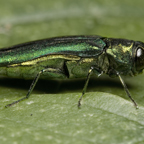 Toggle Favorite The emerald ash borer (EAB) is an invasi...
Toggle Favorite The emerald ash borer (EAB) is an invasi...The emerald ash borer (EAB) is an invasive insect species from Asia that infects and kills black ash trees. The Akwesasne Task Force on the Environment works with other local, state, and federal organizations to protect healthy ash trees and prevent the spread of EAB infestation. 2007
-
Image 2 of 10
 Toggle Favorite Dead and dying branches at the top of a ...
Toggle Favorite Dead and dying branches at the top of a ...Dead and dying branches at the top of a black ash tree signal emerald ash borer infestation, because branches above the infestation are cut off from the supply of nutrients traveling up the tree. 2005
-
Image 3 of 10
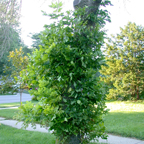 Toggle Favorite An emerald ash borer kills an ash tree b...
Toggle Favorite An emerald ash borer kills an ash tree b...An emerald ash borer kills an ash tree by eating into its trunk and stealing its nutrients. This slowly strangles the tree by preventing food from traveling past the infected area. Epicormic growth occurs when the tree produces shoots around the infestation to try to get enough food to survive. 2006
-
Image 4 of 10
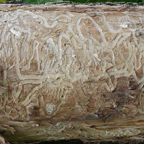 Toggle Favorite Gallery tracks are tunnel-like paths mad...
Toggle Favorite Gallery tracks are tunnel-like paths mad...Gallery tracks are tunnel-like paths made by emerald ash borer larvae as they eat their way through the trunk of a black ash tree. Found just under the bark of the tree, these tracks are one of the first signs of EAB infestation forestry experts look for. 2006
-
Image 5 of 10
 Toggle Favorite This is a close-up image of an emerald a...
Toggle Favorite This is a close-up image of an emerald a...This is a close-up image of an emerald ash borer larva, a young form of the insect, as it eats its way through the cork cambium layer of an ash tree. Once the larvae hatch from their eggs, their constant eating creates long tunnel-like pathways, or gallery tracks, throughout the wood of the tree. 2002
-
Image 6 of 10
 Toggle Favorite "When I was a kid, it seemed like, just ...
Toggle Favorite "When I was a kid, it seemed like, just ...Junior Cook, Mohawk elder
"When I was a kid, it seemed like, just about, I would say 90% of families on this reserve made baskets. There was just an overharvesting through the years."
-
Image 7 of 10
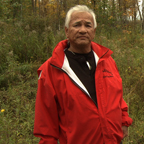 Toggle Favorite "The emerald ash borer is going to be th...
Toggle Favorite "The emerald ash borer is going to be th...Richard David, basketmaker and assistant director, Department of Environment, Mohawk Council of Akwesasne
"The emerald ash borer is going to be the one that is going to devastate our basketmakers here."
-
Image 8 of 10
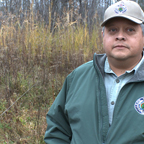 Toggle Favorite "Some of the visual clues for a tree tha..
Toggle Favorite "Some of the visual clues for a tree tha..Les Benedict, assistant director, Environment Division, Saint Regis Mohawk Tribe
"Some of the visual clues for a tree that might be infested would be side shoots, epicormic growth. Because what emerald ash borer does is ... it basically girdles the tree."
-
Image 9 of 10
 Toggle Favorite "When we first saw it, the USDA estimate...
Toggle Favorite "When we first saw it, the USDA estimate...Richard David, basketmaker and assistant director, Department of Environment, Mohawk Council of Akwesasne
"When we first saw it, the USDA estimated that it'd be about 35 years that we would have to worry about it down here. But the bug has moved a lot faster than that."
-
Image 10 of 10
 Toggle Favorite "About four million trees a year are cut...
Toggle Favorite "About four million trees a year are cut...Les Benedict, assistant director, Environment Division, Saint Regis Mohawk Tribe
"About four million trees a year are cut to manufacture paper. Well, seven billion trees in this country alone are under a threat by emerald ash borer."
Take Notes for Story Project
Take notes and save images to help answer these questions. Your images and notes will be saved to the Story Project where you can use them to create your own slideshow.


